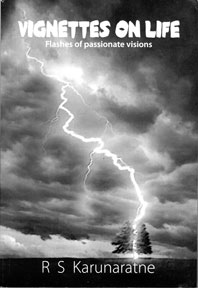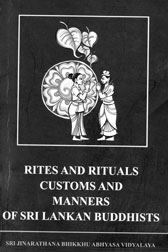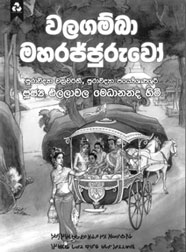|

Vignettes on Life:
Moves at a fast and exciting pace
Reviewed by Gwen Herat
Being one of Sri Lanka's prolific feature writers, the versatility of
R. S. Karunaratne stretches in many directions. The sustainability of
wholesome English language depends on writers of his calibre in Sri
Lanka. We lack the old school charm found therein. But in forceful
writers like him, it rests comfortably upon their shoulders. Few can be
counted upon one's fingers in the subjects that Karunaratne specialises
in. The new generation of writers tends to use 'hip hop' and slang
language for elaboration or subject it to a point of no return.
Karunaratne writes with motivation and is inspirational to the new crop
of clean young writers who struggle to surface in the literary world. He
selects his words with utmost care and weaves them into beautiful
passages. Karunaratne's chosen subjects give him the liberty to go wild
with freedom. There is an incandescence about his writing and in
principle, it triumphs. While he lavishes his gift of writing, he never
overlaps the same subject. An ample and delightful set of essays
revolves around psychology, philosophy, everyday life and people. The
fragrance that Karunaratne finds in people and their character makes it
evident that he is a keen observer of man and his emotion.
 In 'VIGNETTES ON LIFE', he bares this concept. He is blessed with a
well-settled mind which makes it easier for him to pick up his pen.
Karunaratne is in no hurry and he is a complete master of what he
writes. He is less witty, and more serious. But he is a writer in
command over the English language. The diverse subjects he had essayed
on, baffle me and make my admiration for his writing grow stronger. In 'VIGNETTES ON LIFE', he bares this concept. He is blessed with a
well-settled mind which makes it easier for him to pick up his pen.
Karunaratne is in no hurry and he is a complete master of what he
writes. He is less witty, and more serious. But he is a writer in
command over the English language. The diverse subjects he had essayed
on, baffle me and make my admiration for his writing grow stronger.
Beyond doubt, the adoration of most literate people of our country
have been profoundly moved by his talent in condensed articles. There is
nothing sexual, sensuous, or erotic meanings in his articles and his
influences are mainly beneficial.
His is a happy memory of laughter and wisdom packed with a
penetrating beauty that pervades his readers. Every line has been
carefully chosen by this writer and it is not possible for me to dwell
on every essay found in the 'VIGNETTES ON LIFE'. But I will settle for
the last essay on 'MYSTERY OF WOMAN' where he pays homage and
benediction to the one who matters most in this whole wide world....
WOMAN, without whom he could not have penned these words, without whom I
may not have penned these lines, without whom you could not have read
these words. Let me quote:
'All the great religions are founded by men. Similarly, great
philosophers of the world such as The Buddha, Plato, Aristotle,
Socrates... happened to be males. Although there are no female religious
leaders, women can take the credit for giving birth to and bringing up
such religious leaders and great thinkers'... (P.182)
Rites and rituals, customs and manners of Sri Lankan
Buddhists:
A handbook of Sri Lankan culture
Reviewed by Kalakeerthi Edwin Ariyadasa
Gangarama Monastery in Colombo has assumed the stature of a high
spiritual centre, with a remarkable pragmatic stance. Under the
versatile guidance of Ven. Galaboda Gnanissara Nayaka Maha Thera, this
eminent Buddhist Institution functions very much like a monastic
university. The Chief Prelate of the Monastery, Ven. Galaboda Gnanissara
Nayaka Maha Thera, quite efficiently directs the young Monks towards a
disciplined way of life, enabling them to achieve personal fulfilment,
in a variety of fields associated with the multiple aspects of religious
practice.
Of these young monks, Ven. Dr. Kirinde Assaji Thera has distinguished
himself, especially by a literary work published bilingually to
celebrate the 65th birthday of his Venerable mentor and revered Gurudev
Ven. Galaboda Gnanissara Nayaka Maha Thera.
To my mind, this impressive study marks the very first occasion, when
the rites, rituals, customs and manners of Sri Lankan Buddhists, have
been presented in one compact publication.
 In effect, it is an extremely valuable guide for all those concerned
with the practice and the study of Sri Lankan Buddhist rites, rituals,
customs and manners. In effect, it is an extremely valuable guide for all those concerned
with the practice and the study of Sri Lankan Buddhist rites, rituals,
customs and manners.
Each nation or communal group, acquires its unique personality, and
its specific identity, through the cultural traits peculiar to it.
When these are meticulously recorded, with a high sense of authority,
as is done in this work, two primary objectives are fulfilled.
They are:
* Such a record, will enable those who are outside a given culture to
understand the way of life of that community. This will make it possible
for those to whom this specific culture is foreign, to refrain from
forms of behaviour, that will offend a given group and will hurt their
susceptibilities.
* This kind of work will make it possible for those within a given
community, to become familiar with the appropriate rites, rituals,
customs and manners, that should be observed and performed on a given
occasion.
The author, Ven. Dr. Kirinde Assaji Thera wrote this book originally
in Sinhala. He has been quite rightly persuaded to bring out this
English version. It must be stated without any ambiguity, that an aura
of special significance is associated with the present English version.
The English version has emerged from a highly worth while perception.
In the presence of certain religious and social situations, many tend
to feel a sense of utter helplessness, not knowing what is proper to do.
This work will dispel that kind of awkwardness.
I must confess, that, I have never come upon before, a book that sets
down the rites and rituals of the Buddhists, with this kind of
ultra-care.
Rites and rituals relating to forms of worship and types of offering
are so elaborately elucidated here, that every home and every
institution should have a copy of this book, as a much-needed treasure.
Over and above the proper rites and rituals, this work indicates what
righteous moral behaviour is. Quoting extensively from Singalovada
Discourse (Advice to Singala) preached by the Supremely Enlightened
Buddha, this work establishes the right moral attitudes for lay life.
A religious ritual, that receives extensive attention now-a-days is
the Bodhi Pooja - offerings to the Bodhi Tree. This book devotes much
space to indicate the right ritual for this form of worship. Good
Governance, receives the attention of this Ven. author, enabling the
establishment of responsible public admiration.
The work is so comprehensively conceptualised, that rituals relating
to all stages of human life are set down here in admirable detail.
The opening chapter has as its theme the rites and rituals associated
with child birth and childhood.
The rites that had been practised over long centuries, to ensure the
protection and safeguarding the pregnant mothers are meticulously
recorded here. Though these have a trace of ancient Indian practices, in
Sri Lanka, they have acquired an indigenous emphasis, due to the
pervasive influence of Buddhist culture. The book elaborates the time
honoured pre-natal preparations, that should be taken care of, to
arrange the proper background for the birth of a fortunate child.
Probably it is in this book, that the whole range of rites and
rituals governing, pregnancy, childbirth, infancy, the naming of the
child, initiation into food, trimming of the hair etc., is quite clearly
described. The priority assigned in all those rites and rituals, to the
spiritual centre - the temple - is clearly indicated as a practice that
dates back to the far past. When the child enters society, through his
initiation into letters, his responsibilities in life begin to receive
articulation.
His evolution into adolescence, youth and marriageable age, is made
up of a whole series of relevant rites and rituals.
The great significance of this book is its capacity to guide people
towards the various rituals, that accompany the stages of a person's
growth.
The knowledge provided by this book saves people from the utter
helplessness, they will otherwise experience, had they not been aware of
the appropriate rituals, well ahead.
This helplessness is seen quite often at wedding ceremonies. In some
instances, people tend to be confused even about the rites and rituals
of alms offering ceremonies.
Rites and rituals associated with funeral ceremonies, are equally
troubling to those who are not familiar with those. These rites and
rituals are quite clearly set down here.
The book roams along, taking the reader to a vast variety of areas
associated with Sri Lankan culture.
The robe-offering ceremony, the New Year celebrations are among such
areas.
This book is adorned with a versatile foreword by Most Venerable
Udugama Sri Buddharakkhita Maha Nayaka Thera, Chief Prelate of the
Asgiriya Chapter of the Siamese Sector.
A felicitatory note is contributed by Prof. Kshanika Sannasgala, Vice
Chancellor, University of Colombo. The central attitude of this book is
highly praiseworthy. In an immortal pronouncement Mahatma Gandhi said
this:
"We must keep all the doors and windows of our house open to all
winds that blow from all sides. But we must remain firmly established on
our feet, to prevent these winds from blowing us off our feet."
This book pinpoints that, we should stand with our feet firmly
planted in the Buddhist culture. When this happens all the alien ways
that blow, will not be able to shake us off our cultural moorings. I am
quite keen to highlight an important aspect of this book. The
traditional rites and rituals specific to our culture are vividly and
elaborately set down in this book.
As a result of this dimension of the book, it takes on the
significance of an anthropological study. Those who are keen to profile
racial or communal groupings, will find this book a mine of information.
I can aver without any hesitation that, even a formal anthropological
study about the multi-faceted cultural traits of Sri Lanka, has not
delved so deeply into Sri Lanka's rites and rituals as this work has
done.
By making this English version available to the global community,
this Venerable author has rendered a highly esteemed service. This book
should be made available especially to educational institutions and
students. Libraries of institutions of higher studies should have this
work in their shelves. All those who utilize this work, will unerringly
recognise in it a unique contribution to the spiritual field, social
mores and anthropological studies of mankind. Saman Kalubowila has
elevated the text of this book, which possesses a highly appealing
typographical personality. We must offer our grateful thanks to this
young scholar Monk Ven. Dr. Kirinde Assaji Thera, for his noble effort.
(The book is published by Sri Jinaratana Bhikkhu Abbhayasa Vidyalaya,
Gangarama Monastery, 61, Sri Jinaratana Road, Hunupitiya, Colombo 2.)
Two new windows on 17th century Dutch rule
Reviewed by Padma Edirisinghe
The way the past shuts itself like a grave is almost astounding. Yet
the clever species known as humans has evolved ingenious ways to dig up
this grave and have a peep. In the limitless passage of time eclipsed,
the 17th century is just a few seconds gone away yet closed above grave
- style but many resourceful humans have endeavoured to dig up this
grave or to use a non-macabre metaphor, have entered this cavern and
opened its treasures for the benefit of others.
The latest in the line of academic treasures unearthed are the
Memoirs of a Dutch governor 1742-43 and a Commander of Jaffna 1748,
namely Daniel Overbeek and Librecht Hooreman. Do these memoirs come
ready and direct, to be comfortably served on a platter to the reader?
No. The passing time has created umpteen problems, mostly connected to
language.
Okay, Dutch is not a dead language and still exists, you would
counter argue. But talk to K.D. Paranavithana, former Professor Dept. of
Humanities, Rajarata University and at present Consultant to the
National Archives who has translated these two memoirs into English.
These are the woes listed.
"The Dutch in which these memoirs have been written is to a great
extent different from the Dutch in vogue today. Further these Memoirs
have been handwritten and time has contributed to decay and illegibility
despite exerted attempts to preserve them. Abbreviations now obsolete
have been used extensively."
I add an additional obvious cause to the list. The doctor is not
Dutch. And here his perseverance is almost remarkable. He is not the
first translator of the memoirs of Dutch governors. Here is the list of
forerunners in the field. R.G. Anthonisz, first Government archivist of
the island, a Dutch Burgher assisted by Sophia Peters, a Dutch female
come over, translated and published the memoirs of following Dutch
governors. Van Goens 1679 Thomas Van Rhee 1697 Jan Simons 1707, H.
Becker 1716 C. Pielat 1734 and Baron Van imhoff 1749. These publications
put out between 1910 and 1915 are minus the Dutch text.
Next, the second Govt archivist, Reimers, again a Dutch Burgher
translates and publishes the memoirs of Maetsuijker 1650, Van goens
1663, Loten 1757 and Schreuder 1752 during the period 1927 to 1947.
These include the Dutch texts too. Next Prof. S. Arsaratnam translates
the memoir of Van Gollonese 1751 in 1974 after a long period. Now Dr.
Paranavithana again after 34 years has put out these two translations.
They have made their debut not only with the original Dutch texts but
along with lengthy introductions, glossaries and interesting notes.
Human interest counts. How did the doctor master his Dutch? Listening to
him this adventure is almost accidental. In the first place his degree
subject was not history but Sinhala. But after campus life he had joined
the National Archives in 1970. There, no one could help getting accosted
with the huge volume of documents written or printed in Dutch that
included the thombus and memoirs of the Dutch governors and other
administrators. The Dutch were neat administrators with almost
everything committed to writing. Unlike the memoirs the thombus entailed
much interest among the public as they were written testimony of land
ownership. The few Dutch left over in the island though now they had
adopted English as their language still could help in translating, these
while the above mentioned officers had already translated the memoirs.
While working on his assigned job at the Archives the young
Paranavithana without any external injunction began studying the 17th
Century Dutch with the help of these translated documents. Soon his
perseverance paid and he was offered a scholarship to Netherlands
establishing a connection with that once Empire building country that
furthered his erudition in the field. As this article is not a biography
of the professor I will stop there..
What are Memoirs? Following description with reference to the Memoirs
of the Dutch administrators, is culled from the introduction to
Overbeek's Memoir by Prof. Paranavithana.
"The instruction to the appointed Governor of Ceylon were framed by
the retiring Governor of the Island on orders of the Governor General
and Council of India. Such instructions were usually framed in the form
of Memoirs for the guidance of the new Governor...the territory under
the jurisdiction of the Governor and Council departments to be
established or organised and generally matters deserving of special
attention were summarized in the memoirs. The memoirs of governors
maintained not only the continuity of the line of instructions but also
amplified and illustrated them to enable their successors to govern more
effectively and a memoir is therefore a comprehensive report submitted
by the governor to his successor."
However, not all Dutch governors left behind memoirs. Some who had
their services terminated abruptly for various reasons seem not to have
left behind their memoirs. Daniel Overbeek, however seem to have had
long term connections with the island serving from time to time in
varied capacities. In fact he could be the only Governor among the three
Western regimes whose family members died prematurely have their
tombstones here. The introduction encases this tragic piece about the
author of the memoir, Overbeek. "He died in Batavia on 9th July 1751,
while functioning as Extra ordinary Councillor of the High Government.
The tombstone of his wife, Elizabeth Overbeek who died at Galle on 28th
October, 1738 and daughter Gesina Elisabeth Overbeek born at Tuticorin
on 11th September 1734 who died in Galle Fort. His son's name Johannes
Adrian Overbeek who died in Colombo on 16th November 1783 is inscribed
on a tombstone in Wolvendahl church in Colombo."
That sure unfolds a family tragedy. Daughter of Overbeek dies at 3
years in Galle while the father was away at Tuticorin and a year later
the mother dies.
The son of course seems to have died at a mature age towards the eve
of Dutch rule that shows that he had not left the island with his
father. Or perhaps Overbeek kept coming back to Paradise Island. That
suffices for the mysterious accounts of his family tragedy that I have
picked up at random from the book. Overbeek despite his personal
misfortunes has put out a very valuable memoir neatly divided into many
sections.
This memoir and the memoir of Hooreman, Dr. Paranavithana has done
full justice to, by translating them and publishing them with the help
of the National Archives to which Institute too we should be grateful.
Hooreman's memoir will be dealt with separately as it contains valuable
information on the Northern peninsula that would arrest current
attention via matters connected to its economic potential.
 Book launch Book launch
"Walagamba Mharajjuruvo"
The latest edition of "Walagamba Maharajjuruvo", written by Puravidya
Chakravarthi Ven. Ellawala Medhananda Thera will be launched at
Dayawansa Jayakody Book Exhibition Hall, Ven. S. Mahinda Mawatha,
Colombo 10 on January 26 at 10 a.m.
Ven. Medhananda Thera is the author of several other books such as "Negenahira
Palatha Ha Uthuru Palathe Sinhala Bauddha Urumaya, Sinhale Maha Raja
Wansha 1 and 2, Wanni Manushika Meheyuma, Navathama Shilalipi Gaveshana,
Aithihasika Kudumbigala, The Sinhala Buddhist Heritage in the East and
the North of Sri Lanka. "Walagamba Maharajjuruvo" is a Dayawansa
Jayakody publication.
Who will win the Presidential Election?
In the book, 'Astrological analysis of the winner of the Presidential
Election of 2010', the author Jagath Jayewardene analyses the horoscopes
of the two main presidential candidates; incumbent President Mahinda
Rajapaksa and his rival General Sarath Fonseka. The book offers a
detailed account of the position of planets in the horoscopes of the two
main candidates for the Presidential Election of 2010.
Among other things, the author has stressed that the booklet is an
astrological analysis of the two main presidential candidates and that
the analysis has been done objectively without any ulterior motive. In
the course of the book the author analyses the pros and cons of the two
personalities and their personal attributes according to astrology. |

